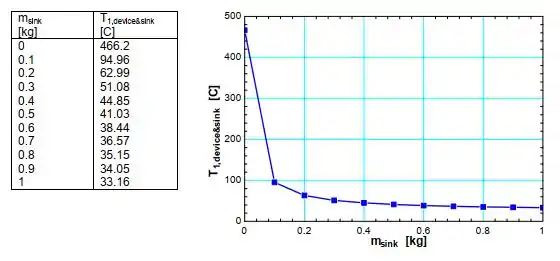Reconsidere o Prob. 4-94. Usando o EES (ou outro programa), estude os efeitos da massa do dissipador de calor na temperatura máxima do dispositivo. Varie a massa do dissipador de calor entre 0 e 1 kg. Trace um gráfico da temperatura máxima versus a massa do dissipador de calor e discuta os resultados.
Passo 1
O problema resolvido pelo EES é
"Knowns:""T_1 is the maximum temperature of the device"Q_dot_out = 25 [W]m_device=20 [g]Cp_device=850 [J/kg-C]A=5 [cm^2]DELTAt=5 [min]T_amb=25 [C]{m_sink=0.5 [kg]}"Cp_al taken from Table A-3(b) at 300K"Cp_al=0.902 [kJ/kg-C]T_2=T_amb
"Solution:""The device without the heat sink is considered to be a closed system.""Conservation of Energy for the closed system:""E_dot_in - E_dot_out = DELTAE_dot, we neglect DELTA KE and DELTA PE for the system, the device."E_dot_in - E_dot_out = DELTAE_dotE_dot_in =0E_dot_out = Q_dot_out"Use the solid material approximation to find the energy change of the device."DELTAE_dot= m_device*convert(g,kg)*Cp_device*(T_2-T_1_device)/(DELTAt*convert(min,s))"The device with the heat sink is considered to be a closed system.""Conservation of Energy for the closed system:""E_dot_in - E_dot_out = DELTAE_dot, we neglect DELTA KE and DELTA PE for the device with the heat sink."E_dot_in - E_dot_out = DELTAE_dot_combined"Use the solid material approximation to find the energy change of the device."DELTAE_dot_combined= (m_device*convert(g,kg)*Cp_device*(T_2-T_1_device&sink)+m_sink*Cp_al*(T_2-T_1_device&sink)*convert(kJ,J))/(DELTAt*convert(min,s)
Passo 2
O gráfico é mostrado na figura abaixo

Resposta
Ei, a resposta está no passo a passo :)